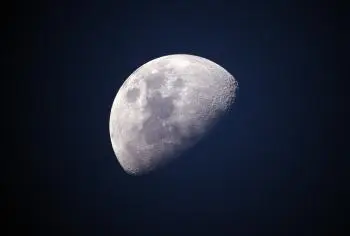
The solar system, in addition to the planets, asteroids and comets, another of the wonders it contains are the moons that orbit around these planetary giants.
In this article, we'll investigate the moons of each of the planets in the solar system, from the iconic moons of Jupiter to the fascinating moons of the outer planets.
Earth's Moon: our moon
The Moon is the only satellite of the Earth, that is, our own natural satellite that has been an object of admiration and study for millennia.
Its impact on the tides and stability of the Earth makes it an essential part of our environment.
The moons of Mars: Phobos and Deimos
Mars, the red planet, has two tiny moons called Phobos and Deimos. Both are irregular in shape and modest in size.
Phobos is in a very close orbit to Mars and is known for its rapid movement in the Martian sky. Deimos, on the other hand, is more distant and has a smaller, quieter appearance.
In addition to Phobos and Deimos, Mars also has smaller, lesser-known moons such as Amalthea and Thebe.
Jupiter's moons: the Galilean ones
Jupiter, the gas giant, is famous for its many moons. Four of the largest moons, known as the "Galilean moons", were discovered by Galileo Galilei in 1610. These are Io, Europa, Ganymede and Callisto.
-
Io: Io is a world of extreme volcanic activity. Its surface is covered with volcanoes and geysers that regularly spew sulfur.
-
Europa: Europa is one of the most exciting targets for space exploration because of its subsurface ocean of liquid water, which could support life.
-
Ganymede: Ganymede is the largest moon in the solar system and has its own magnetic field. It is also believed to have a subsurface ocean.
-
Callisto: Callisto is one of the oldest and most cratered moons in the solar system. Its surface shows signs of a long and turbulent past.
In addition to the moons mentioned, Jupiter is also home to many other smaller moons, such as Amalthea and Thebe.
Saturn's moons: Titan, Enceladus and Mimas
Saturn is known for its majestic rings, but it is also home to a notable collection of moons. The three most important moons of Saturn are Titan, Enceladus and Mimas:
-
Titan is Saturn's largest moon and has a dense atmosphere. It is an important target for astrobiological research due to its lakes and rivers of liquid methane and ethane on its surface.
-
Enceladus is known for its geysers of water that expel water from its surface. These geysers suggest the presence of a subsurface ocean and make it an intriguing location in the search for life.
-
Mimas is known for its unusual appearance, resembling the "Death Star" from Star Wars due to a large crater on its surface.
Saturn also has many other moons such as Dione, Rhea and Iapetus.
The moons of Uranus
Uranus, the tilted ice giant, has a lesser-known set of moons. Some of the most important are:
-
Miranda: is a moon with unique and varied geology, displaying a variety of features from canyons to ridges and terraces.
-
Oberon and Titania: They are the largest moons on the planet and have cratered and fractured surfaces.
-
Caliban and Sycorax: These moons are known for their retrograde orbit, which means they move in the opposite direction to the rotation of Uranus.
Along with the moons mentioned, Uranus has several smaller moons, including Ariel, Umbriel, and Belinda, among others.
Neptune's moons
Neptune's most prominent moon is Triton, which is notable for its retrograde orbit. Triton also has nitrogen geysers emanating from its surface, making it an interesting target for research.
Neptune also has other moons, such as Proteus, Nereid, Larisa, Galatea, Despina and Halimede that further enrich the diversity of this outer planet.
Planets of the solar system without moons
In the solar system, the planets Mercury and Venus are notable for being the only ones that do not have known moons. Mercury, the closest planet to the Sun, is small and its proximity to the Sun makes it difficult to retain moons in orbit.
On the other hand, Venus, a planet similar to Earth in terms of size and composition, also lacks known moons, and although the exact reason is not completely clear, it is thought that past events may have expelled any moons it may have had.


